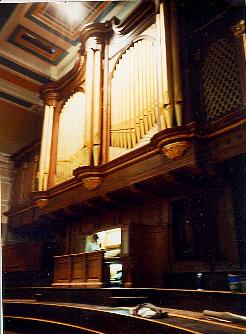
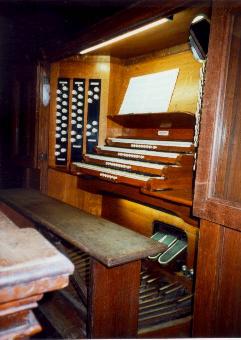
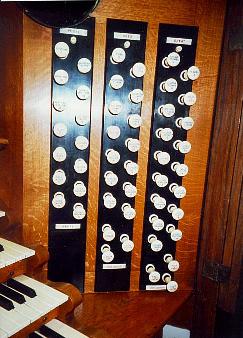
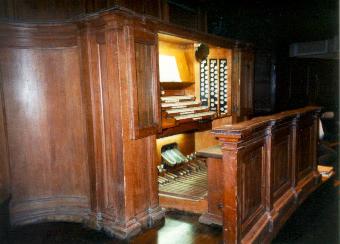
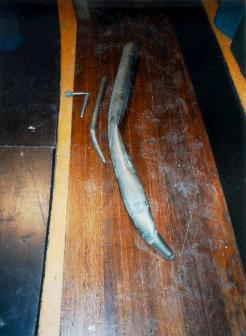
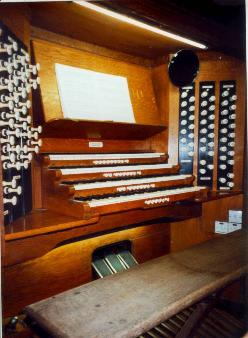
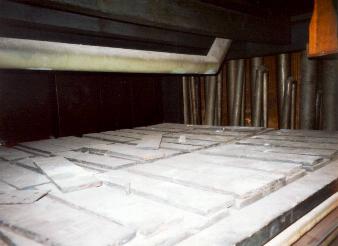
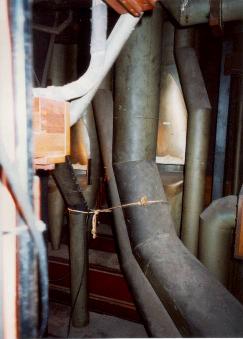
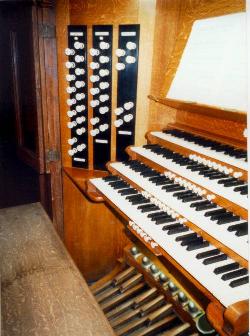
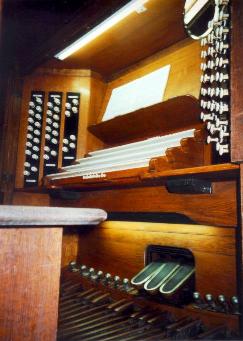
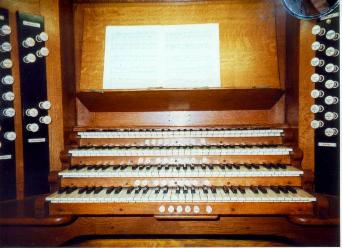

Genesis
In 1858 Newcastle Corporation cast around for an organ for its newly constructed Town Hall � a building designed by John Johnstone and which incorporated the former Corn Exchange. The building has long gone although Pevsner described it as a �distinguished classical building�. The two major firms in London at this period were Hill and Gray & Davison. G&D�s organs at Glasgow City Hall (1852), Birmingham Music Hall (1856) and the Crystal Palace (1857) were much admired and in 1859 they completed a remarkable instrument for Leeds Town Hall to the designs of Henry Smart. Perhaps it was these organs which swayed the Corporation�s minds for they placed an order with Gray and Davison in 1858 for an organ with 3 manuals and pedal which was opened in 1862 - it cost the councillors �3000.
The stoplist is in the 3rd edition of Hopkins and Rimbault. It was certainly an expensive acquisition: G&D�s 1861 organ for Llandaff Cathedral (now at Usk PC) with 3 manuals and 33 stops cost just �900. However, the new organ was up-to-date with fashionable new stops, among them several exotically named flutes. There were two manual choruses to mixture on Great and swell; 16 8 4 reeds on the Great, and a 32� full-compass Pedal organ with a reed. Here, surely, was an organ of which to be proud � for a start all of Bach�s organ works could be played on it (not possible on many organs of that period outside London). The Corporation must have felt proud of themselves in spite of having parted with over 3 times the money that the Llandaff Dean and Chapter had in return for an organ only 10 stops larger. There were two problems. The first was that by and large the quality of workmanship and materials was not high in English organbuilding of that date � the great Parisian organ builder Aristide Cavaill�-Coll had been appalled when he examined some of Hill�s organs less than twenty years earlier. The second problem was perhaps more serious�
In the same year, 1862, Edmund Schulze�s magnificent organ in Doncaster Parish Church was finished. It opened the ears of Britain�s organists to a new and much more powerful sound world. Two years later he completed a 3 manual organ for St Mary, Tyne Dock. Local organists now had a chance to experience Schulze�s voicing at first hand � and appreciate the shortcomings of their English Victorian organs. William Rea, organist to the Corporation, was only too aware of this and complained bitterly about the lack of power and poor construction of the organ. Stephen Bicknell has suggested that the Usk organ �might well have been amongst those criticised on the grounds of lack of power and indifferent quality of materials�. Although a fine organist, Rea must have felt short-changed at having to play what became an increasingly old-fashioned organ. He never got what he wanted at the Town Hall, but instead was responsible for the installation of a number of organs by TC Lewis on Tyneside with Diapason choruses directly inspired by those of Schulze. By the turn of the century Gray and Davison�s organ was regarded as �ill-made, incomplete, and unsatisfactory� but even with a lengthy plea for its replacement in the Evening Chronicle for June 6 1900, the council opted merely for mechanical improvements and a few extra stops.
After work by Vincent of Sunderland in 1901, the organ had 4 manuals and 53 stops on tubular pneumatic action. Henry S Vincent had been building organs since 1880 and this was one of a number of rebuilds which the firm undertook at this period (another notable one was the rebuild of the 1832 Elliot and Hill organ in St Thomas� Chapel, Barras Bridge).
The organ was sold in the late 1920s, but its whereabouts are unknown. Unaltered Gray and Davison organs from this period are rare although locally, there is an 1881 III/21 at Rock, an 1873 II/12 at Ellingham, and an 1860 II/13 at Winston Methodist church in Durham in a remarkable case.
Civic Pride
The Corporation appointed an advisory committee to oversee the installation of a new organ in the recently completed municipal concert hall that had been designed by the London firm of Nicholas and Dixon-Spain. The committee was chaired by Alderman AJ Robinson (also Chair of the Council�s Schools and Charities Committee), with Dr William Ellis (organist of Newcastle Cathedral) and Dr JE Hutchinson (organist of Jesmond Parish Church). The premier builder in the country at that time was undoubtedly Harrison and Harrison. Willis had very little to show for his work since the end of WW1 � neither of his heroic organs for Liverpool or Westminster Cathedrals was yet finished. The Harrisons had a string of highly successful organs in cathedrals and concert halls in their portfolio, and they had an enviable reputation for quality. In selecting Harrison and Harrison�s scheme was selected the committee bought a Rolls-Royce of an organ. If the Tyne Bridge of 1928 can be regarded as one of the ultimate symbols of Geordie civic pride, then this most magnificent organ can be regarded as another.
If there had been any deficiencies in the design and construction of the original Town Hall organ these were remedied in Harrison�s 1929 instrument. At last, Newcastle had a remarkably complete concert hall organ in a fine concert hall. What characteristics does this organ have? At last we have the power, dreamed of by Hill in 1840 and envied by Rea in 1860, with the stentorian Solo Tuba, the ear-shattering Orchestral Trumpets, and the awe-inspiring Pedal Contra Ophicleide. Gravitas is provided by the Double Open Wood, a stop whose presence is felt rather than heard but whose effect is unmistakable. The Diapason chorus on the Great organ, directly inspired by that of Schulze at Doncaster, culminates in a five rank quint mixture. The Choir has a gentler set of stops for quiet accompaniment. The Swell provides us with a rich set of reedy timbres to fill and amplify those of the Great. The Solo is a repository of a rich range of colour, including the relatively rare French Horn and the extraordinary chorus of Orchestral Trumpets. The console is, for the time, lavishly provided with accessories to assist the organist�s task including adjustable pistons.
Here we have a perfect example of The Imperial Organ (to borrow Stephen Bicknell's coinage). The Corporation lost no time in using the organ for concerts and recitals. Among the organists who played this organ were Marcel Dupr� and Fernando Germani. Local organists also made an appearance � one of George Sutcliffe�s proudest claims was that he had given the first local performance of Roger-Ducasse�s Pastorale on this organ.
Indifference
From the early 1960s recitals were shared with those on the newly rebuilt organ in St Thomas Church � all funded by the Corporation. The Newcastle and District Society of Organists became involved with the organisation of the recitals � the City Hall programmes were often ambitious and wide ranging. In March 1962 Newcastle cathedral organist Colin Ross ended his recital with Reubke�s Sonata on the 94th Psalm; Fernando Germani treated the lunchtime audience in October 1964 with Hindemith�s First Sonata and Reger�s massive Fantasia on �Hallelujah, Gott zu loben�. Joseph Bucher included Franck�s Grande Piece Symphonique in his concert and Walter Pach explored an intriguing range of European composers notably Franz Schmidt and the first UK performance of his Introduction and Passacaglia in F#. Indeed there were several recitalists from Eastern Europe among them Milan Slechta from Prague who played Petr Eben�s Laudes in June 1966. One of the last concerts to be played on this organ was given by Conrad Eden from Durham Cathedral who contributed a gloriously eclectic mix of music by Leighton, Fricker, Is�lfsson, Durufl�, McCabe, Milner and Garth Edmundson.
From about 1970 onwards these recitals took place almost exclusively in St Thomas, and the City Council must have begun to wonder whether they had a rather expensive white elephant on their hands in the City Hall. The design and voicing were by then deeply unfashionable. The ideas of another Harrison, G Donald, had percolated across the Atlantic, and had manifested themselves in a rather alarming fashion in London in 1954. Suddenly everyone wanted organs with strangely named (and sometimes strange sounding) stops. St Thomas� organ provided the Quintadena, Tierce, Cromorne, Larigot, Schalmei and Siffl�te that were absent in the City Hall. Nobody wanted corpulent Tubas, leathered lips, and heavy wind pressures. The Newcastle organ was regarded by many as, at best, an irrelevance. As with its predecessor it too had fallen victim to the whims of fashion.
Not surprisingly in 1974 the newly constituted City Council lost no time in dropping organ recital funding. With so few public airings, there was little incentive to continue regular maintenance. Rumours began to circulate, notably that the action had begun to deteriorate. Ciphers were commonplace. Fewer and fewer stops or notes worked. In short, it was neglected and unloved. At least there was no money to spoil it.
Renaissance
The organ now is in far from pristine condition. Dust lies thick on the pipework and the soundboards. There has been water damage. Some pipes have been damaged. There are wind leaks. The combination action is unreliable. Some of the trunking is held in place with string. It was thought for a long time by many that the heating in the hall had split or warped the soundboards.
The organ was required for a private booking in early 1999. NBCR (John Ollett) was asked to investigate the possibility of returning the organ to playing order. He discovered that the organ was in not quite the poor state that people imagined. After many hours of work, he reconnected what had come adrift; he cleaned what was visibly grimy; he plugged many of the wind leaks; he repaired damaged pipes; and tuned the most out-of-tune notes. There is still much work to be done, and sufficient funds will have to be found for future work.
Where are the pipes behind the ornamental casework? Immediately above the console is the main soundboard for the Great Organ. Behind it lies the Pedal Mixture V. Above the Great is the Swell Organ, with the unenclosed Solo Tuba immediately in front. At the same level as the Great behind the grilles on the left side of the case is the Choir Organ � in front of the Choir box are the Great Reeds. Behind the grilles on the right side of the case is the Solo organ, with the French Horn and Orchestral Trumpets just behind the shutters of the Solo box. At the back and to the left are the pipes of the Pedal Open Wood ranks; to the right, the Pedal Ophicleide unit. The windchests for these are at the same level as the console. Underneath the Choir and Solo boxes are the double-rise bellows.
A White Elephant?
The wheel has turned full circle � the ideas of the 1960s are now seen to be misguided. This didn�t stop cosmetic alterations to hundreds of organs. Harrison�s 1908 masterpiece at Ely was transformed out of all recognition in 1975. The alterations to Lichfield in the 1970s have been largely undone in a recent restoration. We�ve begun to listen to the organ of the early 20C with new ears. Harrison�s organs at St Mary Redcliffe, Bristol (1911), and the Caird Hall, Dundee (1923) have been lovingly restored. Binns� 1906 magnum opus in the Albert Hall Nottingham as been restored and is regularly used for recitals and concerts. Taylor�s 3 manual organ (which boasts a Tuba and both flue and reed 32� stops) has been restored and in used for concerts and academic ceremonies by both Universities in Leicester.
An opportunity awaits�
Pedal: flues 4.5" - 6"; reeds 20"
Choir: 4"
Great: flues 4.5" - 6"; reeds 15"
Swell: flues, Vox Humana and Oboe 5"; reeds 10"
Solo: flues and orchestral reeds 7"; French Horn, Orchestral Trumpets, Tuba 20"
The stoplist is available from the National Pipe Organ Register.
Some of the softer registers are of great beauty; the Swell strings with their octave couplers coupled to the Choir strings with the octave coupler provide a warm shimmer of sound with the pedal 32' underneath. The Great Diapasons 16 8 and 4 coupled to Full Swell with the box slowly opening is awe-inspiring. The Solo French Horn is smooth and rich, and not over-powering in spite of being of 20" wind. The Great chorus from 16 to Mixture V is clearly inspired by those of Schulze and Lewis; adding Full Swell, the Trombas 16 8 4, and Full Pedal for good measure provides a tremendous body of sound. The Tuba is rich, heavy and sonorous, but the most intriguing stops are the Orchestral Trumpets 16 8 4 on the Solo. This is an extended rank, but the tone is fiery and very brassy. I have not heard similar sounds on a Harrison of that period (although he did provide them for Lord Glentanar (1924), Worcester Cathedral (1925), Royal Albert Hall (1933), All Saint's Margaret Street (1911) and Westminster Abbey (1937). The reed at All Saint's was voiced by Henry Gunther. Are these other example the work of WC Jones? Full Organ is staggeringly loud and the 32's cause the staging to vibrate!
I had the opportunity to visit the organ a few times during the summer, and I have some pictures of my first visit below. I've subsequently been inside, and some more pictures will appear here shortly. I turned pages for the "Last Night of the Millenium" concert on 7th December 1999, and played for Emmanuel College's Carol Concert in 15th December.
I've played again for Emmanuel College on 10th December 2002. More notes are off, particularly on the borrowed pedal ranks. A cypher on the Solo orchestral Trumpet which had manifested itself during the afternoon practice disappeared in the evening, although the 16' Contra Viola decided to whimper at various inopportune moments.